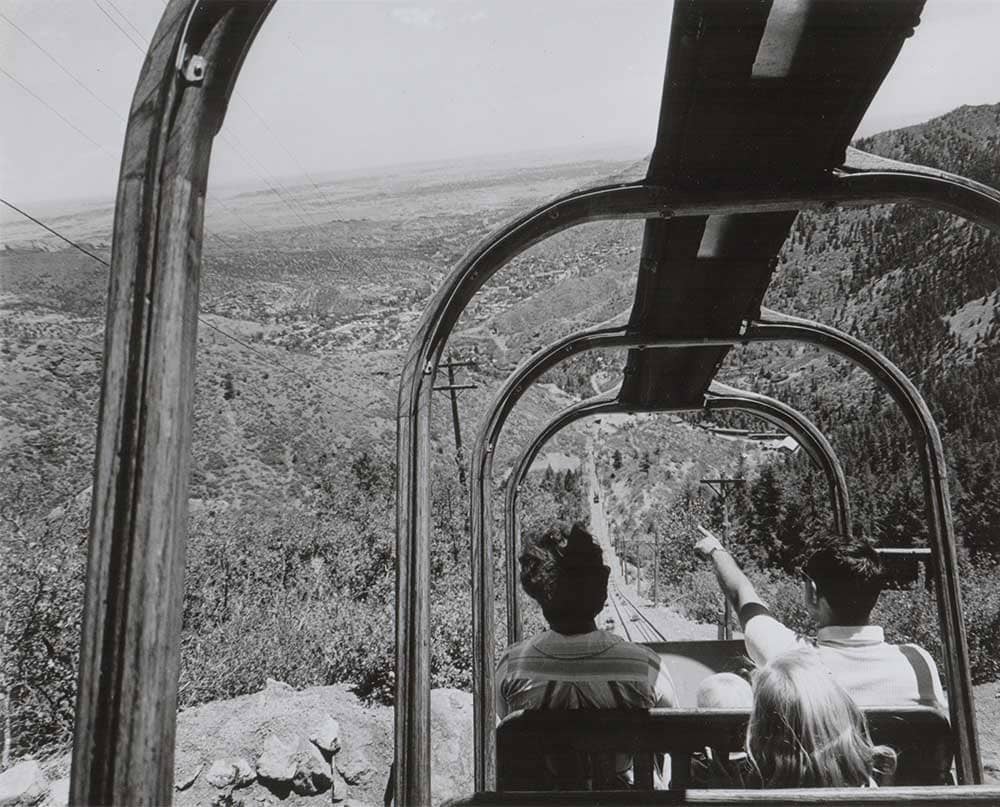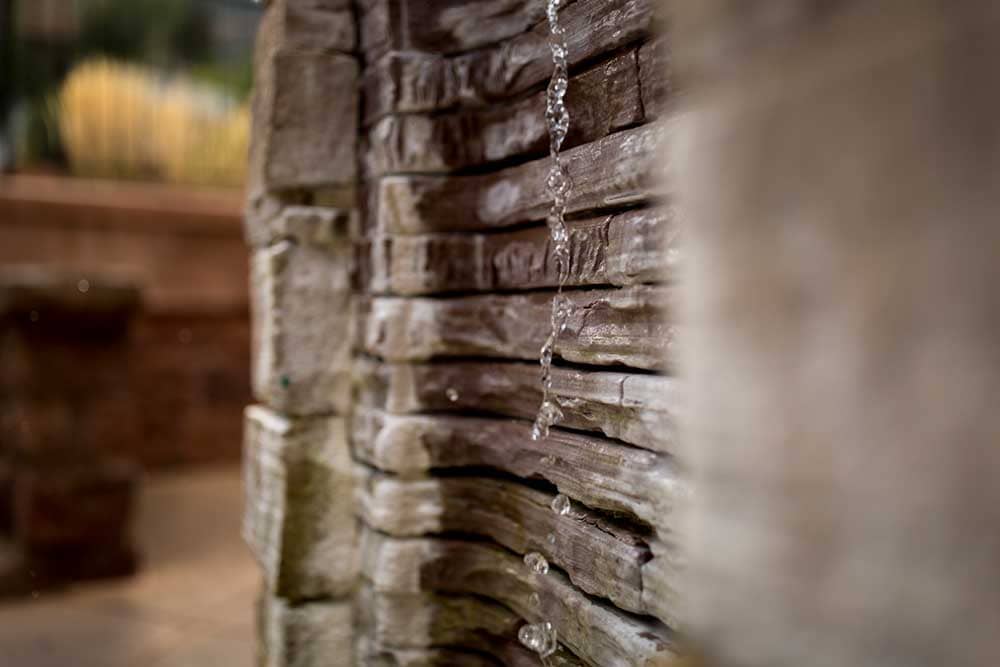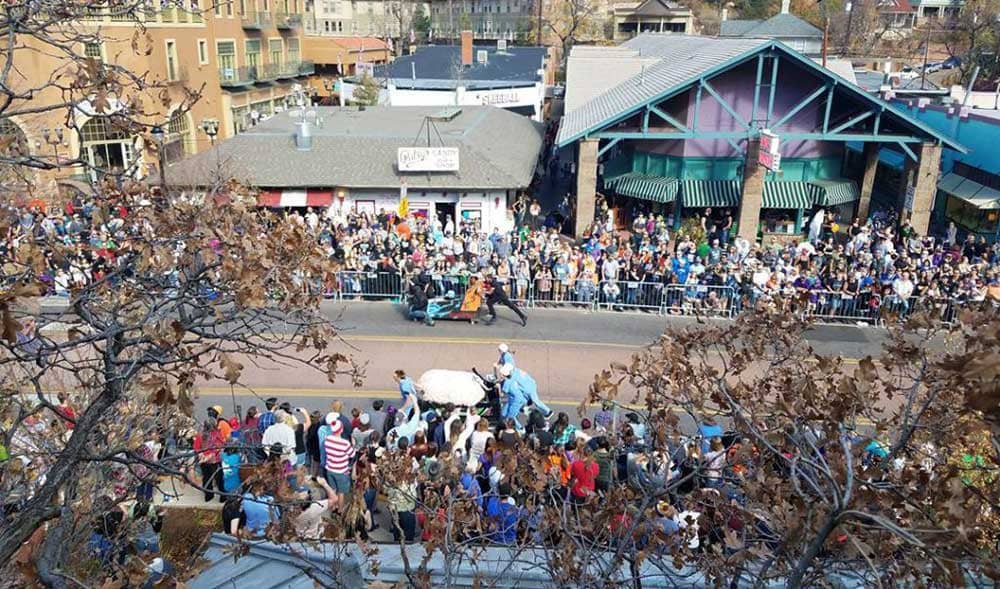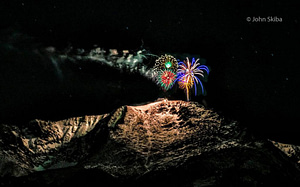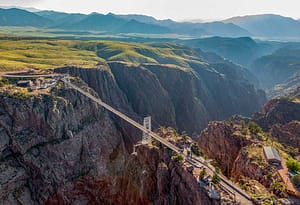The Early History of Manitou Springs
Manitou Springs celebrated its 150th anniversary in 2022, with all the joy and fanfare it so rightly deserved. Fifteen decades is a long time to be around and still enjoy so much success. Even the Rolling Stones haven’t hit that milestone yet (though we are entirely confident they could). As we cruise into a new decade for the charming small town, we thought it might be fun to take a jaunt back in time to the early days of Manitou Springs. After all, in order to really get where you’re going, it’s important to remember where you’ve been. And Manitou? It’s been around for a lot! Enjoy a little retrospective on the early days of Manitou Springs. Why did people move here? Are there really springs? Why on earth do Manitoids run coffins through downtown every Halloween season? Let’s hop in the Delorean (that’s a car for you young folks) and find out!
Manitou Springs: A Haven for Tuberculosis Patients
Manitou Springs was founded as a tourist destination and spa-style community for rich folks and, surprisingly, those suffering from tuberculosis. General William J. Palmer (founder of the easterly neighboring city of Colorado Springs) and Dr. William Bell co-founded the town as a bit of a resort town for visitors and wellness center for the chronically ill. While the doctors of the past may not have known the exact science behind the “cure”, high altitude and clean air greatly increased the lifespan and quality of life for tuberculosis patients of the time. In fact, they still do. Turns out that mycobacterium tuberculosis doesn’t enjoy life at altitude (we aren’t offended). We have more advanced treatment methods today, but there’s no doubt about it — that Rocky Mountain high was, and is, good for curing what ails you.
Tuberculosis patients flocked to the town to enjoy the restorative effects of thin air on their lungs and other areas of the body ravaged by TB. Nearby Colorado Springs was also a TB destination. In a 2012 Gazette article, the Pioneer Museum’s Matt Mayberry noted, “Tuberculosis treatment was our industry. Other than the military, I don’t think there was a bigger economic driver in Colorado Springs.”
Many patients lived in windowed “huts” designed by Charles Fox Gardiner to maximize the amount of fresh air patients breathed 24/7/365. The huts were appointed with all the things a patient might need to live comfortably. Most designs looked like tiny turrets stuck in the ground. In the past, one might have considered it a rather small living space, but fans of the tiny home craze sweeping the United States would probably beg to differ.
You won’t find many of the tuberculosis huts still standing in Manitou Springs today. However, if you travel down Manitou Avenue, you’ll find one of the most prominent ones across from the Manitou Springs Arcade. It is currently home to Totally NUTS which sells, as you guessed it, toast. Just kidding, they sell cinnamon roasted nuts and tasty beverages.
Manitou’s Resort Aesthetic: The Springs of Manitou Springs
Of course, the town was more than a hillside riddled with tiny homes and recovering patients. Remember earlier, where we discussed it as a resort destination? Manitou Springs was incredibly popular for people looking for wellness in other ways. Co-founder Dr. Bell loved it so much he built his home along the way into town. You can tour it today and even enjoy a fine dining experience if you’re inclined. The Briarhurst Manor always has something special on the menu.
In addition to the fresh air, Manitou Springs had other restorative properties, namely, its natural springs. Nope, it’s not just a name. Manitou Springs is the real deal, with multiple springs that pump gallons of effervescent mineral water up to 8 taps located throughout town. It’s like Manitou Springs was turning out seltzer way before seltzer was cool. The Manitou Springs Mineral Foundation notes that the bubbling is caused by the presence of carbon dioxide.
According to their website, “By volume, the carbon dioxide content of gas at the springs ranges up to nearly 99 percent. In contrast, shallow groundwater containing dissolved gas originating from the atmosphere or soil typically has less than 1 percent by volume. Due to the purity of the gas composition, helium isotope evidence suggests that a significant portion of the carbon dioxide likely originates at depth from Earth’s outer mantle and migrates to the Manitou Springs aquifer along the Rampart Range and Ute Pass Fault Zones.”
That’s some pretty fancy water. Rare icy water run through a prehistoric aquifer and poured right into your favorite hydro flask next to an arcade under the sunshine sky of the Colorado Rockies. And it’s free. Of course, there was a time when it wasn’t so easy to get the water from tap to table. There wasn’t even a tap. Of course, where there’s money to be made, there will be entrepreneurs to make it and producing bottled water from the mountains of wellness was definitely a money maker.
If you have a chance to visit the Manitou Springs Heritage Center during one of your visits to the Pikes Peak region, you’ll get to know the history of Manitou’s fancy healing water a bit more in depth. They have a collection of bottles from the early days of the town, when two bottling plants battled for supremacy in the sparkling water game. While the claims the proprietors may have made to sell the water were a bit of a stretch, there is no doubt that the springs contained abundant minerals. If you check out the Mineral Foundation’s website, you’ll see they all contain a combination of calcium, magnesium, zinc, lithium and many other minerals. Each spring has its own unique taste and mineral composition. Take a little tour next time you’re in town to find your favorite.
The Infamous Emma of Coffin Race Fame
Perhaps the most famous person to move to Manitou Springs for its healing properties was the sassy and determined Emma Crawford. Why is she so special we all still talk about her 160 years after her birth? More importantly, why do Manitoids get decked out in corpse costumes and race coffins through town in her honor? We’ve got answers. Some of them might even be true!
Emma Crawford may have died in Manitou Springs, but she was born and raised in Massachusetts. The Manitou Springs Heritage Center notes that Emma was an accomplished musician, with words like “perfection” thrown around quite liberally when discussing her skill. She also played violin, cello, viola and mandolin. Emma never took lessons to gain these skills. She did, however, teach others. Starting when she was twelve.
The problem with Emma was that she suffered from a chronic illness believed to be tuberculosis. While cities like Boston were excellent for convenience, the sooty, filthy air was terrible for those afflicted with illnesses, particularly respiratory illnesses. That’s how Emma found herself living with her mother in Manitou Springs at the age of 26.
No good biography is complete without at least a little bit of a love story and Emma’s relationship with one William Hildebrand was certainly sweet enough for even the most curmudgeonly of hearts. Hildebrand was working on the Pikes Peak Cog Railway when he met Emma and pretty much all sources from the time note he was enamored with her — her looks, her talents and her extremely sassy and tenacious spirit. We’re pretty sure the latter is really what hooked Hildebrand; what man wouldn’t want a powerhouse of a lady like Emma?
Emma was also passionate about the great outdoors. It would seem that even in the 1800s, hiking and exploring were popular activities. The hills and valleys surrounding the town were crafted just for folks like Emma. She conquered them all. The most notable of those, Red Mountain, was of particular note, as many did not believe she had achieved the summit. Emma, as beleaguered then as modern women are today, knew that was coming. She tied a scarf to a tree at the top to be sure anyone who came to check her story would have to eat crow. So proud was Emma and so in love with the spot that she asked to be buried under that same tree. Unfortunately for Emma, that day came all too soon
Just two years after moving to Manitou Springs and before her marriage to William, Emma passed away from illness. Her suitor was crushed by her loss, as were her many friends and neighbors. That dear man then honored Emma’s wishes to bury her on Red Mountain.
It was no easy feat. It took multiple people and more than one effort to get there. Give the hike a try without a coffin sometime and you’ll soon realize that William’s love for Emma was profound. Most people don’t even like carrying a water bottle up that mountain, much less a whole human in a wooden box. William buried Emma beneath the tree and covered her coffin with rocks. Whether or not he was really allowed to bury a person outside of a cemetery is not really known. We suspect that no one was super excited about heading up to retrieve and carry down a coffin, so Emma rested in view of stunning beauty … for a time.
Sometime between 1912 and 1924, Emma’s grave was rudely interred to make way for the Red Mountain Incline and an ill-fated collection of buildings (you can still visit the site today). And this is where the story gets a little weird. Remember how we mentioned coffin racing on Manitou Avenue? Do you see where this is going? After having her bones dumped unceremoniously nearby to make way for progress, legend has it that a brutal storm sent that coffin sailing down the mountain and straight into Manitou Springs. Also as legend has it, the community was quite dismayed to find human remains outside in the street. They didn’t have quite the macabre sense of humor future generations of Manitou would develop.
There’s a more boring version of the tale we have to share in the interest of honesty. Avert your eyes if you prefer fun and joy and all good things. Newer reports claim that it wasn’t a coffin that was found, just some bones and a nameplate in a bundle against the side of the house. While that may be true, we much prefer to think of the alternative — majestic Emma sailing a coffin into the heart of Manitou Springs, arms raised high like a kid on a roller coaster, ready to raise a little hell one last time. When you see residents sprinting down Manitou Avenue dressed like skeletons beside a unicorn coffin, just know that that is the spirit those folks are channeling.
The wild, the weird and the wellness have never really left Manitou Springs. From its earliest origins to its present-day form, Manitou Springs has remained a fascinating, wonderful and beautifully strange place filled with unique people and enduring history. We hope the next time you wander the streets that you’ll pause a little longer and think about just how cool it is to wander through time even as you live right here in the present.
